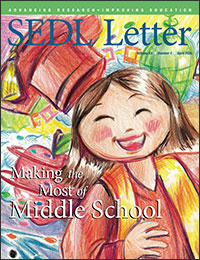SEDL Letter, Volume XX, Number 1 (April 2008): Making the Most of Middle School

Authors: Debbie Ritenour (editor), Geoffrey Alan, Leslie Blair, J. Michael Hall, Wendy Jones
| Price: Available free online |
Available online: Full text, PDF
![]()
Whether you went to "middle school" or "junior high," you undoubtedly have distinct memories of that particular stage of your life. Grades 6–8 tend to be trying years—and not just for students. Educators struggle with teaching children who are rapidly becoming young adults. Gone are the relatively docile and eager-to-please elementary-school children. Within a matter of a year, they are replaced with adolescents struggling with developmental and social issues. Teaching these students is no easy task, and it’s not surprising that many middle school teachers find themselves frustrated and overwhelmed.
In this issue of SEDL Letter, we tackle some of the issues middle school educators face. We discuss the lack of national policy addressing these years. We learn from a former middle school principal how families can help their middle school students. We look at the research that shows how our middle schoolers are falling behind in math compared to their peers in other nations—and what we can do about it. We debate whether we should revamp middle schools and go back to the K–8 system. Finally, we discuss how afterschool programs can attract and retain this hard-to-reach audience.
In this issue of SEDL Letter, we tackle some of the issues middle school educators face. We discuss the lack of national policy addressing these years. We learn from a former middle school principal how families can help their middle school students. We look at the research that shows how our middle schoolers are falling behind in math compared to their peers in other nations—and what we can do about it. We debate whether we should revamp middle schools and go back to the K–8 system. Finally, we discuss how afterschool programs can attract and retain this hard-to-reach audience.
